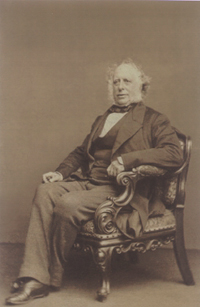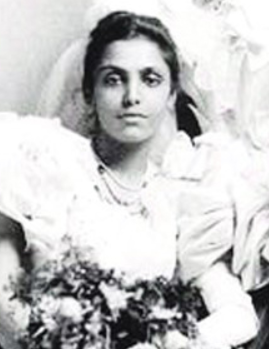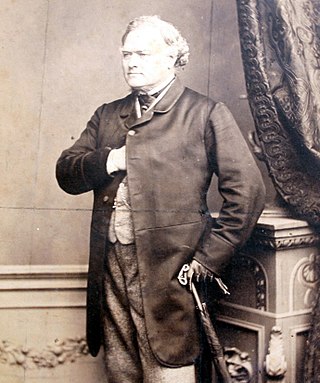Related Research Articles

The Koh-i-Noor, also spelled Koh-e-Noor,Kohinoor and Koh-i-Nur, is one of the largest cut diamonds in the world, weighing 105.6 carats (21.12 g). It is part of the Crown Jewels of the United Kingdom. The diamond is currently set in the Crown of Queen Elizabeth The Queen Mother.

Maharaja Sir Duleep Singh, GCSI, or Sir Dalip Singh, and later in life nicknamed the "Black Prince of Perthshire", was the last Maharaja of the Sikh Empire. He was Maharaja Ranjit Singh's youngest son, the only child of Maharani Jind Kaur.

Asaf Jah VI, also known as Sir Mir Mahboob Ali Khan Siddiqi Bayafandi, was the 9th Nizam of Hyderabad. He ruled Hyderabad State, one of the princely states of India, between 1869 and 1911.

Maharani Jind Kaur was regent of the Sikh Empire from 1843 until 29 March 1847. After the Sikh Empire was dissolved on 29 March 1847 the Sikhs claimed her as the Maharani and successor of Maharaja Duleep Singh. However, on the same day the British took full control and refused to accept the claims.

Raja Lala Deen Dayal, famously known as Raja Deen Dayal) was an Indian photographer. His career began in the mid-1870s as a commissioned photographer; eventually he set up studios in Indore, Mumbai and Hyderabad. He became the court photographer to the sixth Nizam of Hyderabad, Mahbub Ali Khan, Asif Jah VI, who awarded him the title Raja Bahadur Musavvir Jung Bahadur, and he was appointed as the photographer to the Viceroy of India in 1885.

Clan Oliphant is a Highland Scottish clan.

Greater Hyderabad Municipal Corporation (GHMC) is the civic body that oversees Hyderabad, the capital and largest city of the Indian state of Telangana. It is the local government for the city of Hyderabad. It is one of the largest municipal corporations in India with a population of 7.9 million and an area of 650 km².
The Treaty of Lahore of 9 March 1846 was a peace-treaty marking the end of the First Anglo-Sikh War. The treaty was concluded, for the British, by the Governor-General Sir Henry Hardinge and two officers of the East India Company and, for the Sikhs, by the seven-year-old Maharaja Duleep Singh and seven members of Hazara, the territory to the south of the river Sutlej and the forts and territory in the Jalandhar Doab between the rivers Sutlej and Beas. In addition, controls were placed on the size of the Lahore army and thirty-six field guns were confiscated. The control of the rivers Sutlej and Beas and part of the Indus passed to the British, with the proviso that this was not to interfere with the passage of passenger boats owned by the Lahore Government. Also, provision was made for the separate sale of all the hilly regions between River Beas and Indus, including Kashmir, by the East India Company at a later date to Gulab Singh, the Raja of Jammu.

The Asaf Jahi was a Muslim dynasty that ruled the Hyderabad State. The family came to India in the late 17th century and became employees of the Mughal Empire. They were great patrons of Persian culture, language, and literature, and the family found ready patronage.
Events in the year 1866 in India.

Sir Frederick Currie, 1st Baronet was a British diplomat, who had a distinguished career in the British East India Company and the Indian Civil Service. His posts included Foreign Secretary to the Government of India, Member of the Supreme Council of India, Resident at Lahore and Chairman of the East India Company.

Princess Bamba Sutherland was the last surviving member of the family that had ruled the Sikh Empire in the Punjab. After a childhood in England, she settled in Lahore, the capital of what had been her father's kingdom, where she was a suffragette and a passionate advocate of self rule and independence of India. She was a close and personal friend of Indian revolutionaries whom she hosted like Lala Lajpat Rai.
Laurence Oliphant, 8th of Condie and 30th Chief of Clan Oliphant, was the member of the United Kingdom Parliament for Perth between 1832 and 1837. He was a Whig and his strong views on reform caused controversy.
Sir Lancelot Oliphant, KCMG, CB was a British diplomat, Ambassador Extraordinary and Plenipotentiary to Belgium, Minister-Plenipotentiary to Luxembourg and Director General of the Foreign Office.
Oliphant or Olyphant is a surname that was established in England and Scotland by a family of Norman origin. The early forms Olifard and Oliphard are believed to allude to an olive branch. Notable people with the surname include:
The 1866 Birthday Honours were appointments by Queen Victoria to various orders and honours to reward and highlight good works by citizens of the British Empire. The appointments were made to celebrate the official birthday of the Queen, and were published in The London Gazette on 25 May and 29 May 1866.

The Black Prince is a 2017 international historical drama film directed by Kavi Raz and featuring the acting debut of Satinder Sartaaj. It tells the story of Duleep Singh, the last Maharajah of the Sikh Empire and the Punjab area, and his relationship with Queen Victoria.

Sir John Spencer Login was a Scottish surgeon in British India, best remembered as the guardian of Maharajah Duleep Singh and the Koh-i-Noor diamond following the annexation of Punjab and Last Treaty of Lahore.
The localities and neighborhoods of Hyderabad have unique oral histories, dating to the time of the Qutb Shahi dynasty, over 400 years ago, and are named after various people and things. Some are named after a major building or structure in the locality, others named for individuals. The names are mostly in Telugu and Urdu, the major languages of the city. This is a list of localities, neighborhoods and streets of Hyderabad and their etymology.

Lena, Lady Login was a Scottish courtier and author. She was involved with educating Duleep Singh, deposed maharaja of the Sikh kingdom of the Punjab, when he was still a child, and later with bringing him to the UK. Queen Victoria asked her to look after another exiled Indian noble, Victoria Gouramma, daughter of the deposed ruler of Coorg, and to find her an acceptable husband.
References
- 1 2 The Red Book of Perthshire, by Gordon MacGregor
- 1 2 Burke's Landed Gentry; 19th edition, "The Kingdom in Scotland"
- 1 2 Burke’s Peerage & Baronetage; 107th edition
- ↑ Hansard
- ↑ "The Calcutta review, Volume 11 (49)". Archived from the original on 17 July 2012. Retrieved 17 January 2012.
- ↑ The Asiatic journal and monthly register for British and foreign ..., Volume 9
- ↑ Journals of the Sieges of the Madras Army (1825)
- ↑ The Oriental herald and journal of general literature, Volume 7
- ↑ "Addiscombe, its heroes and men of note; by Colonel H. M. Vibart
- ↑ Hyderabad - Secunderabad Blog
- ↑ Neoliberal inscriptions and contestations in Hyderabad By Anant Maringanti,
- ↑ Journal, Volume 1 By Royal Asiatic Society of Bengal
- ↑ Debates at India House on the Case Deposed Raja of Satara and Impeachment of Col C Ovans 1845
- 1 2 Hansard 11 July 1848
- ↑ The Satara raj, 1818-1848: a study in history, administration, and culture. By Sumitra Kulkarni (1995) (pages 21, 22, 23, 24)
- ↑ Timaru Herald, Rōrahi XXVIII, Putanga 1964, 15 Huitanguru 1878, Page 4
- ↑ Hansard Commons Debate 28 January 1878 vol 237 c529
- ↑ Page 3 of Colonies And India, 15 December 1877
- ↑ "My dear Nawab Saheb" by Harriet Ronken Lynton. 1974. Publisher University of California Press ISBN 0520024427
- ↑ Sir John Login and Duleep Singh